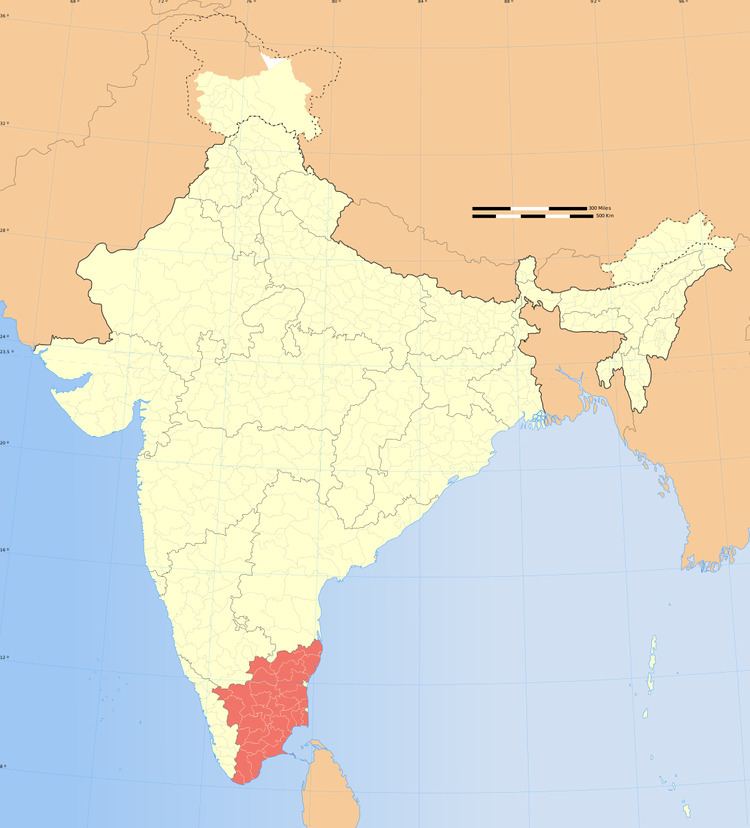Appointer Governor of Tamil Nadu Formation 17 December 1920 | Inaugural holder A. Subbarayalu Reddiar | |
 | ||
The complete list of Chief Ministers of Tamil Nadu consists of the heads of government in the history of the state of Tamil Nadu in India since 1920. The area under the present-day state of Tamil Nadu has been part of different territorial configurations under Madras Presidency and Madras State in its history.
Contents
Madras Presidency
The Madras Presidency, headquartered in Fort St. George, was a province of British India that comprised present day Tamil Nadu, the Malabar region of North Kerala, the coastal and Rayalaseema regions of Andhra Pradesh, and the Bellary, Dakshina Kannada, and Udupi districts of Karnataka. It was established in 1653 to be the headquarters of the English settlements on the Coromandel Coast.
The territory under the presidency comprised only Madraspatnam and surrounding regions. But, after the Anglo-French wars and the consequent alliance between the English East India Company and the Nawab of Arcot, it was expanded to comprise the region from Northern Circars to Cape Comorin. Alongside, the governance structure also evolved from a modest secretariat with a single secretary for the Public Department in 1670 to six departments overseen by a Chief Secretary by 1920. With the enactment of Government of India Act 1919, the first legislature was formed in 1920 after general elections. The term of the legislative council was three years. It had 132 members of whom 34 were nominated by the Governor and the rest were elected.
Under the Government of India Act 1935, a bicameral legislature was set up with a legislative assembly consisting of 215 members and a legislative council having 56 members. The first legislative assembly under this act was constituted in July 1937. The legislative council was a permanent body with a third of its members retiring every three years.
In 1939, the British government declared India's entrance into World War II without consulting provincial governments. The Indian National Congress protested by asking all its elected representatives to resign from the governments. Congress came back to power in 1946 after new provincial elections.
Madras State
Madras State, precursor to the present day state of Tamil Nadu, was created after India became a republic on 26 January 1950. It comprised present-day Tamil Nadu and parts of present-day Andhra Pradesh, Karnataka and Kerala. The first legislature of the Madras State to be elected on the basis of universal suffrage was constituted on 1 March 1952, after the general elections held in January 1952.
The state was split up along linguistic lines in 1953, carving out Andhra State. Under the States Reorganisation Act, 1956, the States of Kerala, and Mysore were carved out of the Madras state. Under the implementation of the Andhra Pradesh and Madras Alteration of Boundaries Act, 1959, with effect from 1 April 1960, Tirutani taluk and Pallipattu sub-taluk of Chittoor district of Andhra Pradesh were transferred to Madras State in exchange for territories from the Chingelput and Salem Districts.
Tamil Nadu
Madras State was renamed as Tamil Nadu (Tamil for Tamil country) on 14 January 1969. The legislative assembly adopted a resolution on 14 May 1986, to abolish the legislative council. Thereafter, the legislative council was abolished through an act of Parliament named the Tamil Nadu Legislative Council (Abolition) Act, 1986 with effect from 1 November 1986. The state legislature is unicameral, and consists of 235 members including one nominated member.
The Chief Minister commands most of the executive powers while the Governor has a largely ceremonial role. The Chief Minister of Tamil Nadu, like other Chief Ministers of India, is elected by legislators of the political party or the coalition which commands a simple majority in the legislative assembly. The tenure of the Chief Minister extends as long as he or she enjoys the confidence of the assembly. The incumbent shall vacate the office in the event of a successful motion of no confidence. Also, the President of India, acting under the recommendations of the Cabinet of Ministers of the Government of India, can dismiss an elected government using certain provisions of Article 356 of the Constitution of India. In 1976, Karunanidhi's government was dismissed and President's rule was imposed on the grounds of corruption. If a vacancy is caused to the office of the Chief Minister due to death, demitting, or dismissal, the Governor can invite another person to form the government and request him or her to move a confidence-seeking motion in the Assembly. In the event of no one enjoying majority support, the Assembly is either dissolved or put in suspended animation and the state comes under President's rule or a caretaker government until fresh elections are held for the assembly. The incumbent shall be disqualified if convicted of a criminal offence with a jail sentence of two years or more. In 2014, Jayalalithaa lost her post due to a special court sentencing her to four years of prison term in the disproportionate assets case.
